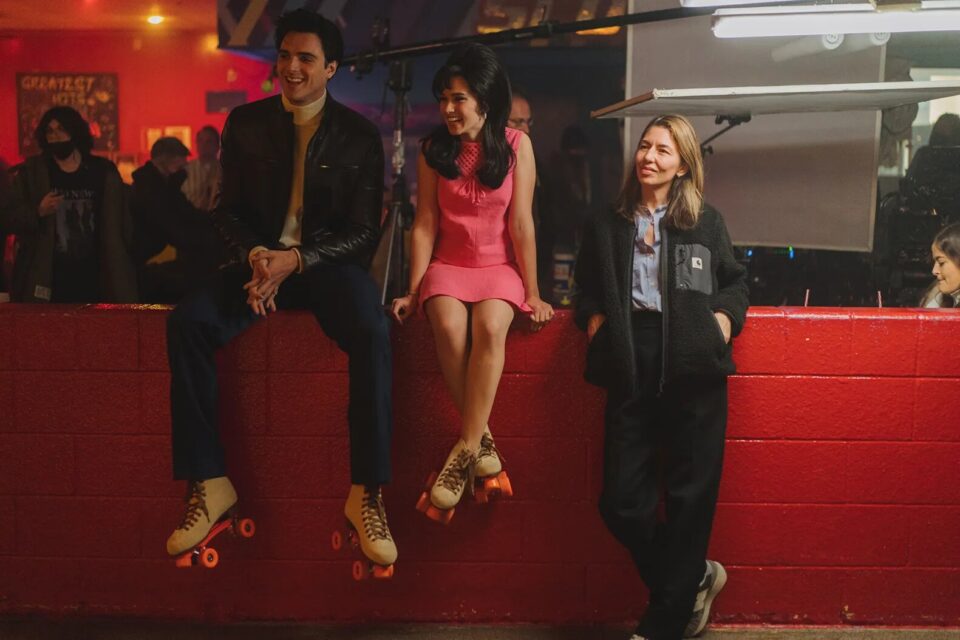From why she used “I Will Always Love You” to casting Cailee Spaeny, here are 11 things Sofia Coppola revealed to us about the making of Priscilla

Jacob Elordi, Cailee Spaeny, and Sofia Coppola on the set of ‘Priscilla.’ SABRINA LANTOS/A24
Sofia Coppola zeroed in on her artistic signatures early on: The very first shot in her debut as a director, the 1998 short film Lick the Star, shows a teenage girl staring pensively out a car window. She did it again with a shot of Kirsten Dunst in a taxi in The Virgin Suicides (actually via her brother, Roman Coppola, who shot second unit). “And then when we were shooting Lost in Translation,” Coppola says over a recent breakfast in a West Village café, “I was like, ‘Roman, can you get the girl-out-the-window shot?’ So it kind of became a thing that we were looking to get, that shot motif.” In her newest film, Priscilla, the girl in the car, and in Graceland, is Priscilla Presley (Cailee Spaeny), whose relationship with Elvis Presley (Jacob Elordi) — which, disturbingly enough, began when she was only 14 and he was 24 — veers between fairy tale and nightmare.
Here’s some of what we learned from Coppola about the movie (and be sure to check out the rest of the career-spanning interview).
Coppola wasn’t a big Elvis Presley fan in her youth. “I didn’t grow up with him being played in our house, so it’s not so much in my upbringing,” she says. “But of course he’s like an American myth — the two of them — and I admire him as a unique artist.”
Coppola worked hard to reserve judgment on her characters. “It was tricky,” she says. “I kept coming back to [Priscilla’s] perspective and her point of view. And I try not to be judgmental of any of the characters and really be as sympathetic as I can to each of them. And I’m really focused on her perspective, but even with the parents, you’re like, “How can anybody let their kid go live with Elvis that young?”… I feel it’s only my job to show what her experience is like, and I think you present things to an audience for them to think about and make their own decisions. She ultimately left and found her identity outside of men, which I thought must have taken so much strength at that time. It was a big deal to have no income and divorce a powerful man. I know what a big deal that was at that time. So I was impressed that she had the strength to do that, to leave after her whole life being shaped by that.”

Coppola wasn’t interested in taking down Elvis Presley — but she resisted calls to leave out the “dark stuff,” including his temper and pill-popping. “I never want to, like, take someone down and disrespect them,” she says. “I think it’s sympathetic to see his struggles and the human side, but definitely there’s so much folklore of him as this god. There was someone that was trying to get me to take out all the dark stuff, someone kind of involved who was thinking about the perception of Elvis in the film. But I really wanted the ups and downs. You can’t have a complex relationship with just the good side.” (The “someone” in question appears to be the late Lisa Marie Presley, who vehemently objected to the movie’s depiction of her dad in emails before her death, according to a new report from Variety.)
The lush visuals of Priscilla represent a key philosophy of Coppola’s. “Beauty is important to me,” she says. “I think in the past I was seeing it as superficial. But now scientists know how important beauty is to humans. And I like creating that, and that’s part of the appeal to me of a visual medium. I love the visual world of Sixties Memphis and Graceland and the shag carpet and the drapes. I love when you go into a movie and you feel lost in another world … There is something sexy and romantic about cars, but especially in that era. It was really fun to shoot the cars.”
When Coppola heard that Baz Luhrmann was making his Elvis biopic, she didn’t mind at all. “I thought it could be a counterpoint,” she says. “Someone was like, “Oh, is that gonna deter you?” And I said, “No, I think it’s even cooler that he’s in the culture and people are thinking of him and we can show the other side. She’s barely a character [in Elvis].”
The Elvis Presley estate blocked Coppola from using any of his recordings, but she only had two or three of his songs in her first cut. “I always knew they might not give us permission, so I tried not to be too attached,” she says. “I love ‘Pocketful of Rainbows.’ My husband played it for me and I listened to it a lot when we were shooting, so I really wanted to use that song. And then when he first leaves for Germany, and there’s a long sad-in-Germany montage, we had him singing “Are You Lonesome Tonight?” and it was really like the voice of Elvis while she was left behind. Anyway, we couldn’t use him, so Phoenix did the instrumental, and I’m really happy with the way the music turned out.”
We did it and I’m happy that the story still works even though we had to cut so much out of it. It was almost like editing before [we made the movie].
The use of Dolly Parton singing “I Will Always Love You” in the film is an allusion to two bits of history — Elvis sang it to Priscilla on the day of their divorce. He also wanted to record the song, but Parton blocked it after his manager, Colonel Tom Parker, demanded 50 percent of the publishing. “I mean, the lyrics are so perfect for that moment because Priscilla still loves him, but she had to move on,” says Coppola. “And I thought it was important to end on a woman’s voice again, because it’s kind of her becoming herself.”
Until she found Cailee Spaeny to play Priscilla, Coppola wasn’t sure how she would find an actress who could embody the same character from ages 14 to 29. “I really didn’t want to switch actresses,” says Coppola. “And my casting people told me about Cailee. And I when I met her she had such a baby face, so I figured she’s believable as younger, and then I figured she could do the older part because she really is in her twenties. And then I asked Kirsten Dunst, who had just worked with her, and she said she was really talented and loved working with her.”
To make Priscilla work within its allotted budget, Coppola had to cut the shooting schedule down from five weeks to four — and she got the news only a week before filming began. “I’m like, how are we going to do that?” she recalls. “It was so hard. But we did it, and I’m happy that the story still works even though we had to cut so much out of it. It was almost like editing before [we made the movie]. The art department, the costumes, I thought they made it look incredible. I was so impressed with their work.” Among the scenes cut from the script were a pregnant Priscilla riding motorcycles with Elvis and his buddies, and a visit from her parents to Graceland.
The moment when Priscilla, at Elvis’ bidding, finally takes on her famous look is deliberately presented almost as a superhero-costume reveal. “I wanted that moment of how she became the Priscilla we know her as,” Coppola says. “With the black hair and the eyeliner, it was kind of like his [Elvis’] creation, his ideal of a woman.”
Coppola always knew she wanted to end the movie with Priscilla leaving Graceland — and not show Elvis’ death. “When I thought about the movie, I wanted it to be, like, her and Graceland,” says Coppola. “That period of her arriving and her leaving. I had to fill in a little at the beginning of how she got there, but to me this was really about her time at Graceland. And I just was so struck with that. I couldn’t believe that she was going to high school while she lived at Graceland. She stayed up all night being the perfect girlfriend and having fun with them and then went to school during the day. I can’t imagine what that was like.”
From Rolling Stone US.
>>> Read full article>>>
Copyright for syndicated content belongs to the linked Source : RollingStoneIndia – https://rollingstoneindia.com/sofia-coppola-priscilla/

























![Forest ecology cannot be reduced to arithmetic, says M.I. Varghese [Interview] – Mongabay-India](https://earth-news.info/wp-content/uploads/2025/12/328946-forest-ecology-cannot-be-reduced-to-arithmetic-says-mi-varghese-interview-mongabay-india-120x86.jpg)





